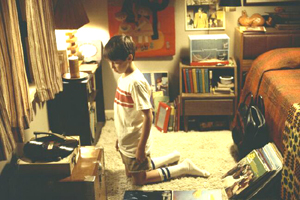Home
Syllabus
E-mail Class
E-mail Craig
Resources
Journal
Discussion
Assignments
Schedule
|
New Media
Writing: The Personal History of a Public Experience
The Essay: 
Write a five-to-seven page essay or account that describes your individual
history with a public experience. A "public experience" is something
that a public experienced and remembers together: a television series,
a local event, the career of a musical group, a forest fire, a news event,
etc. The "public" may be a local (a town or region), national
or global.
The purpose of the essay is to place the public experience in the context
of your personal history--to "situate" that experience--in a
way that makes the reader see the public experience differently from how
it appears in purely in public terms.
Examples
Movies make this personal/public move all the time:
- think about how movie Titanic
attached new meaning to the famous, public disaster by placing it in
the context of a personal story.
- Almost Famous--one
kid's experience of 1973 rock-music culture.
- Muriel's Wedding--A
girl from Porpoise Spit, Australia, figures out what life's about with
the help of the music of Abba.
The Timeline Exercise:
Use this Timeline to brainstorm
ideas of how the course of your life has been influenced by public experiences.
(When you click the Timeline link, it you don't get a window offering
you the option to download the file, right-click the link to get that
option.) Open the file with Word or another word-processing application,
and fill out the file online. Save it to your Zip in 5230 > newmedia.
The following Web sites might give you some ideas for public events to
put on your timeline, though you may also have luck doing search via Google.
Then, the Web Site:
After you've written, turned in, and received feedback on the essay,
create a Web site about the same "personal history/public experience"
using information and materials from your essay. What content can you
repurpose, what must you lose, and what additional material must go out
and find? Experiment with maintaining the personal perspective and tone--to
distinguish your site from large, corporate-style sites on the topic already
out there on the Web--while still creating a publicly useful site. Look
for organizing principles other than straight-line narrative, which works
best in print, not hypertext.
In creating the Web site, try to realize the following goals:
- iconology: In moving from print to digital form, you'll want
to "visualize" your subject with pictures, maps, diagrams.
You'll also want to unify all the pages by repeating certain visual
elements (a banner, for instance) that create a consistent sense of
place or "brand."
- texture: In words and images, you want to create a sense of
voice, of immediacy, or of experience (rather than just giving a lot
of information). Try to bring from your essay the interest and energy
of your own voice and perspective. While a Web site is perhaps not as
easy to make personal as a personal essay, it does not have to be impersonal
and dull.
- hypertext: When you wrote your essay, you could expect a reader
to read from the first word to the last, sequentially and completely.
Not all readers will live up to that expectation, but that's their fault!
When you make a Web site, however, you can't expect the same thing of
"users." You need to reorganize the presentation your subject
matter into non-sequential "chunks" (pages) that you'll make
available through a menu of links. These links will be expressed as
a set of verbal labels that should be meaningful to the audience, and
give the audience a kind of map of your subject matter.
Turning in the Project
1. Post the Web site by the due date/time and send the URL to the specified
Webx discussion.
2. Print out a copy of the Web pages, annotate
them, and hand them in by the due date specified on the schedule.
3. Attach to the back of the printout the original copy of the essay
with my markings on it.
|

